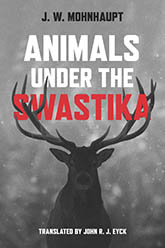|
Animals under the Swastika
J. W. Mohnhaupt
Translated by John R. J. Eyck
“The book triumphs with its detailed combination of pleasant-to-read stories and well-researched historical facts. . . . [Mohnhaupt] highlights a large, up-to-now overlooked facet of how deeply Nazi ideology penetrated all areas of society.”
—FALTER
A compelling addition to our understanding of Nazi intellectual life
Never before or since have animals played as significant a role in German history as they did during the Third Reich. Potato beetles and silkworms were used as weapons of war, pigs were used in propaganda, and dog breeding served the Nazis as a model for their racial theories. Paradoxically, some animals were put under special protection while some humans were simultaneously declared unworthy of living. Ultimately, the ways in which Nazis conceptualized and used animals—both literally and symbolically—reveals much about their racist and bigoted attitudes toward other humans.
Drawing from diaries, journals, school textbooks, and printed propaganda, J.W. Mohnhaupt tells these animals’ stories vividly and with an eye for everyday detail, focusing each chapter on a different facet of Nazism by way of a specific animal species: red deer, horses, cats, and more. Animals under the Swastika illustrates the complicated, thought-provoking relationship between Nazis and animals.
J.W. Mohnhaupt is a journalist based in Magdeburg and Vienna and the author of Der Zoo der Anderen (The Zookeeper’s War). His work has appeared in Der Spiegel, Die Zeit, and PM History, among others.
John R. J. Eyck is an independent translator and scholar based in New York City.
Praise for the German edition (Tiere im Nationalsozialismus)
“By zooming in on man and his relationship to animals, the book avoids belittlement; it in no way moves the atrocities of the Nazis to the background. Just the opposite: with each chapter, the reader becomes a witness. . . . Rarely has a book on animals been more political, rarely has racial fanaticism in such detail been more noticeable.”
—Die Zeit
“Informative and descriptive and never lurid. . . . Worth the read. With every animal he mentions—be it a louse, dog, cat, pig, horse, or deer—Mohnhaupt makes the Nazi ideology clear.”
—Spektrum der Wissenschaft
Table of Contents
Contents
Introduction: The World behind the Wire
1 Blood Ties
2 Digestive Affinities
3 Drawing the Curtain on Larval Stages
4 Morituri
5 Raufbold
6 Not Really Stroganoff
Conclusion: Until the Last Dog Is Hung
Acknowledgments
Notes
Works Cited
Index
|

Larger images
August 2022
LC: 2021049409 DD
248 pp. 6 x 9
|

